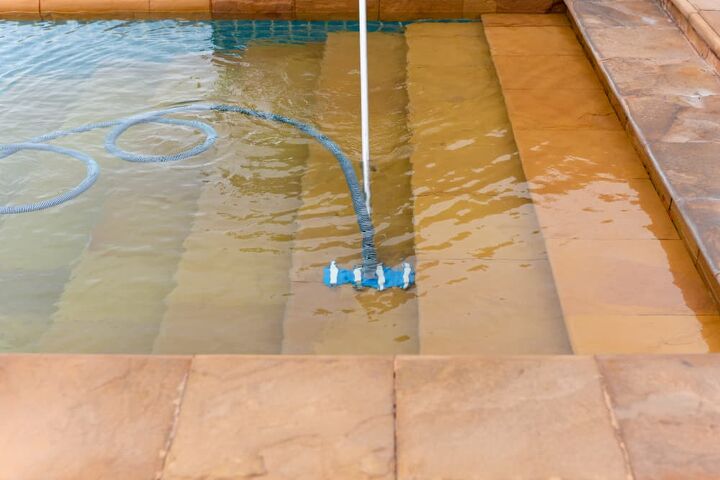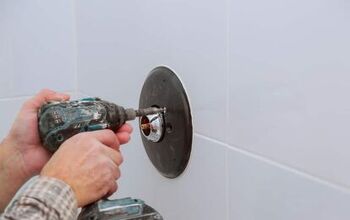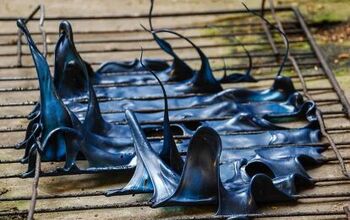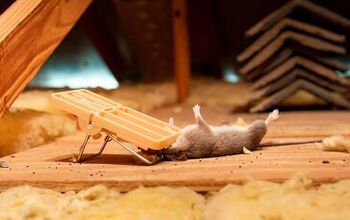How To Remove Dirt From The Bottom Of The Pool (Do This!)

When you swim in almost any pool, you’ll end up tracking some small amount of dirt into the pool’s water. It’s just the way things are. If you have an outdoor pool in a windy area, you might also get some dirt blown in after a particularly strong gust of wind. Obviously, that’s pretty gross. So, how can you clean dirt that’s managed to settle at the bottom of your pool?
If you’re new to pool ownership and need to clean dirt at the bottom of your pool, you’ll be happy to know that there are several ways to do it. The best options include:
- An Automated Suction Tool
- A Pool Broom And Vacuum
- A Filter And Pump
- The Mitt On The Pole Trick
All of these methods have their own perks and pitfalls, and which you can choose all depends on what you have available to you. This watery topic offers a lot of knowledge to be had, so let’s dive in.
Do You a Need Pool, Spa, or Hot Tub Contractor?
Get free, zero-commitment quotes from pro contractors near you.

Why Is There Dirt At The Bottom Of My Pool, Anyway?
Even the most pristine pool will have moments where dirt accumulates on their floors. Did you ever wonder why the dirt’s there in the first place? It’s actually from a wide range of different things, really:
- Algae accumulates in almost all pools. It’s a natural part of pool ownership.
- Dirt gets blown in or tracked in when people enter the pool.
- If left uncovered, leaves, debris, and bird poop can all find their way into the pool.
- If your pool filter has been reversed, there’s a good chance that your filter may have pushed out debris into the pool.
The Best Cleaning Methods For A Dirty Pool
The one good thing about pools is that you do not have to drain them in order to access the grit and grime at the bottom. So, don’t worry about that. Let’s talk about each of the most important methods you need to know.
Automated Suction Tools
If you have a Roomba 960 or anything similar, you already know what an automated suction tool is like for your carpeting. Believe it or not, they have similar tools for pools, and yes, they focus on scanning the bottom of the pool to suck up grime. However, it’s important to know a couple of things about this technique:
- Suction tools only work with filters and are made to pick up fine dirt. If we’re talking about sand, this might work. Even so, you will need to run your pool’s filter for a while before you start using them. You need a clean-ish pool to make this happen.
- You will need to connect the suction tool’s rods and pieces to the filter. Yes, each suction tool is a little different when it comes to installation, but what you can always expect is that you will need some assembly.
- Automated tools are a little bit of a misnomer. Sure, they will move around, but occasionally you’ll need to direct them.
- Make sure to clean the filter and the tank, if it has one. You will accumulate some debris otherwise.
A Pool Broom And Vacuum
If you want to get rid of a clump of dirt or just want to get your pool cleaner, manual labor is often the way to go. Even if you don’t have a specific amount of dirt that you want to remove, you should give your pool’s floor and sides a manual cleaning with a pool broom and vacuum from time to time.
Like you would with a regular broom, make sure to use a scrubbing motion with your pool broom. This is the only way to ensure that your pool will be rid of algae and other debris since this stuff can cling to items hard. This method works better after you’ve used a filter and a pump.
A Filter And Pump
Technically, this is more about removing debris that is floating around in the water. However, that debris can settle to the bottom of the pool. By using a filter and pump, chances are high that you probably will notice a nice change in the quality of cleanliness at the bottom of your pool over time.
Using your pool’s filter and pump is primarily a way to cleanse the water, rather than the actual ground. This doesn’t mean you should skip it, though. This method is typically used as a “primer” for other methods on here since most of them will need to have relatively clean pool water in order to be properly done.
Most filters
The Mitt On The Pole Trick
Do you have a particular area that you want to clean on the floor of the pool? In most cases, the broom and vacuum will work best, but we don’t always have access to a working one. This is a good time to get a telescoping pole from your pool vacuum and a microfiber car cleaning mitt. Here’s how to use this trick:
- Start by placing the mitt on the pole. You might need to attach it with a rubber band or a hair tie if it keeps sliding off.
- Place the mitt in the pool, and start scrubbing away at the bottom of the pool. Make sure to focus on the problematic areas, since this is a spot-specific cleaning method.
- You will need to rinse and clean the microfiber pad multiple times through the cleaning session. Since microfiber picks up everything, you will need multiple mitts or several cleaning sessions to lift up all the dirt and debris.
How To Prevent Dirt On The Bottom Of The Pool
It’s worth noting that you can’t always prevent the dirt from accumulating at the bottom of your pool. However, you can reduce the frequency that you need to clean your pool if you take a couple of preventative measures. Here are the biggest ones to take:
- Shock and clean your pool on a regular basis. This is the fastest and easiest way to decrease the amount of buildup due to algae or bacterial growth.
- Cover your pool when it’s not in use. It’s common sense, but a pool cover is one of the best ways to prevent debris from falling into your pool. Covers keep bird poop out, dust from coating your pool’s water, and also prevent leaves from sinking into your water.
- Wipe your feet before you enter the pool. It sounds a little over-cautious, but every little action helps.
- Use a pool net to catch fallen leaves as soon as they fall. The easiest way to make sure you don’t have to scrub the bottom of your pool is to catch things before they reach the bottom.
- Keep an eye on your water conditions. Pools that are not kept at the right pH are more prone to accumulating bacteria and algae at a rapid rate. By making sure to test your water readings are golden, you’re reducing cleaning requirements.
- Run your pool filter for at least eight hours before you hit the pool. Realistically, you should try to run a pool filter fairly frequently. Some even run the filter continuously, just because it helps reduce the amount of debris that settles on your pool floor so greatly. However, even a little filtering can go a long, long way.
Do You a Need Pool, Spa, or Hot Tub Contractor?
Get free, zero-commitment quotes from pro contractors near you.

Related Questions
What is that orange-brown dust at the bottom of my pool?
While it could be sand, the more likely culprit for orange-ish brown grit at the bottom of your pool is probably mustard algae. Mustard algae holds a yellowish tone that can range from yellow-green to a yellow-brown in hue. Most people mistake it for sand and dirt, but in reality, it’s an organism.If you have mustard algae, do not try to kill it off with chlorine. It won’t work; mustard algae is notoriously chlorine-resistant. You will need a specialized cleaner for this algae to be removed.
What is the white buildup that is growing on the sides of my pool?
In most cases, the white buildup that you might be seeing on the sides of your pool will be calcium deposits. It’s just like the hard water buildup you might notice on your bathtub or your faucets. This suggests that you need to soften the water in your pool, and in most cases, careful treatment will fix the issue entirely.If you don’t see an improvement in your pool quality, it could be a white algae taking hold in your water. However, this would be somewhat unusual and shouldn’t be your first suspicion.
How long will it take to remove algae from my pool?
Algae can be fairly tenacious, but it’s no match for a shock treatment. Even with the shock, it will take a fair amount of time for the algae to get killed off and filtered out of your pool. Most pools will need at least 24 hours for algae to be removed. In some rare cases, it can take as much as two to three days before you have a fully cleaned pool.

Ossiana Tepfenhart is an expert writer, focusing on interior design and general home tips. Writing is her life, and it's what she does best. Her interests include art and real estate investments.
More by Ossiana Tepfenhart
























![How To Reset A Whirlpool Cabrio Washer [In 5 Easy Steps!]](https://cdn-fastly.upgradedhome.com/media/2023/07/31/9076531/how-to-reset-a-whirlpool-cabrio-washer-in-5-easy-steps.jpg?size=350x220)


